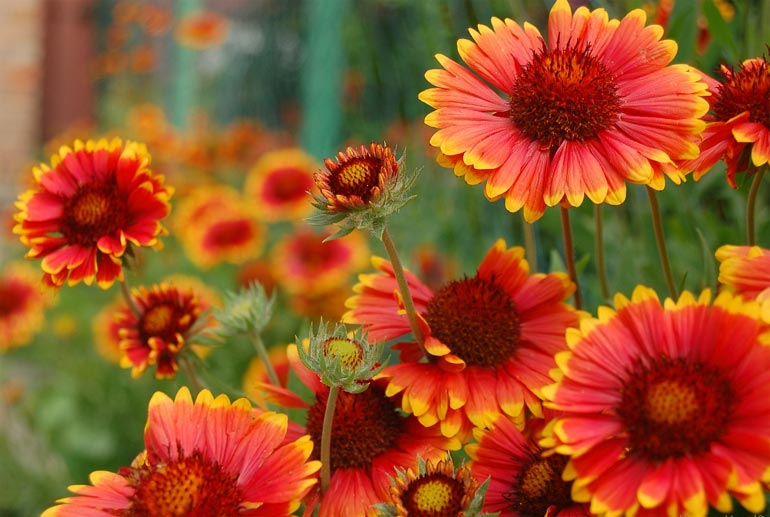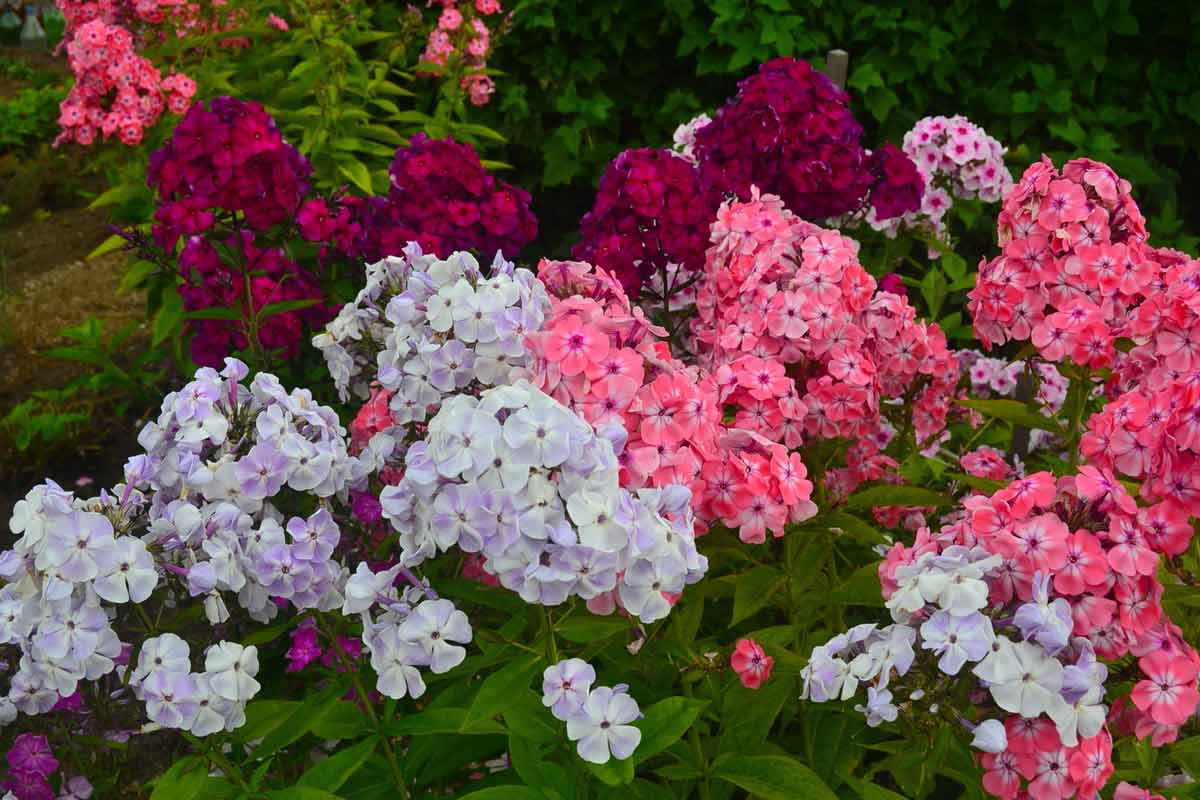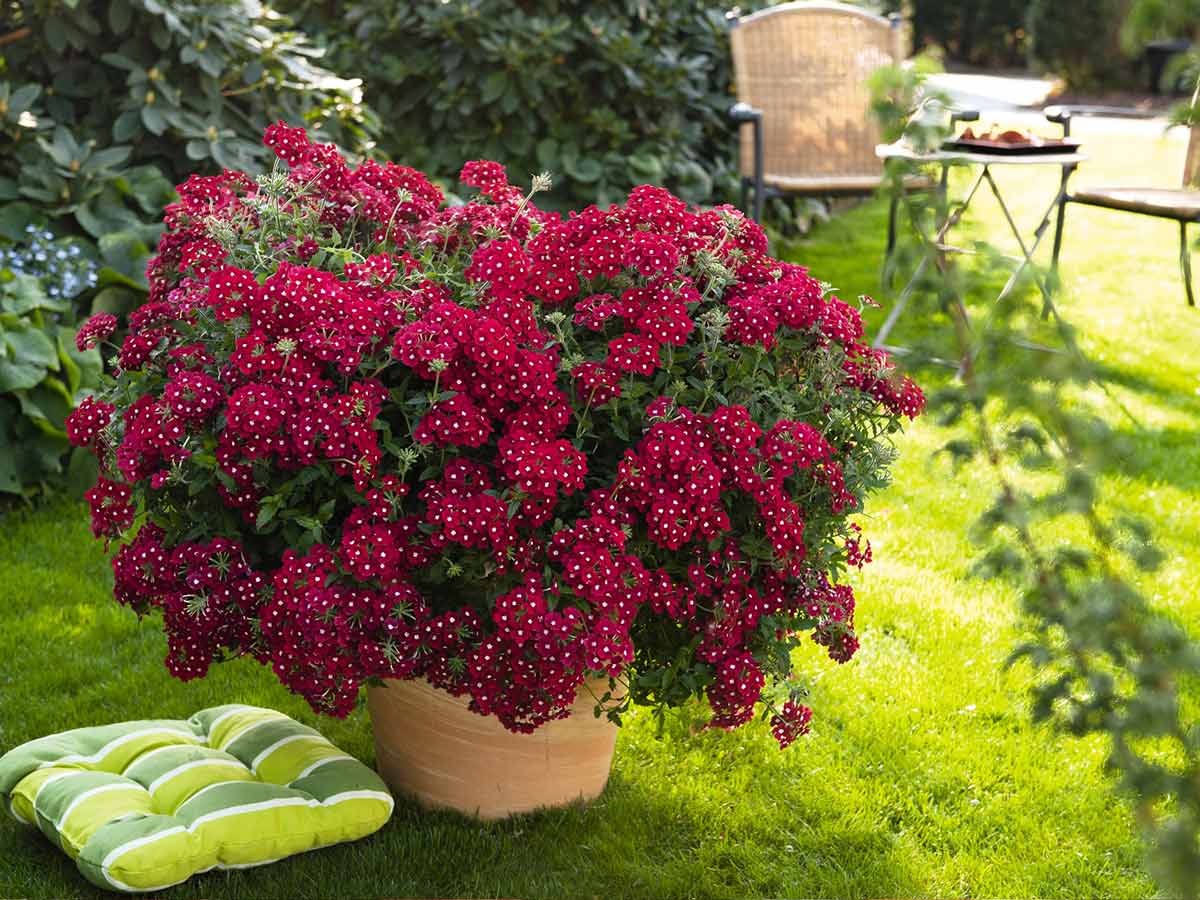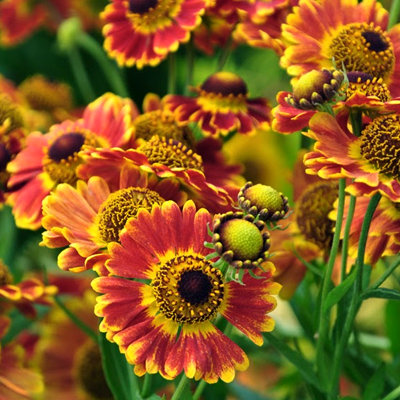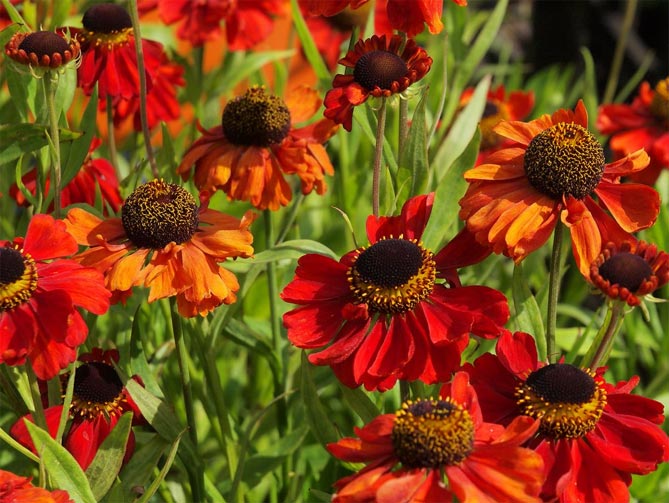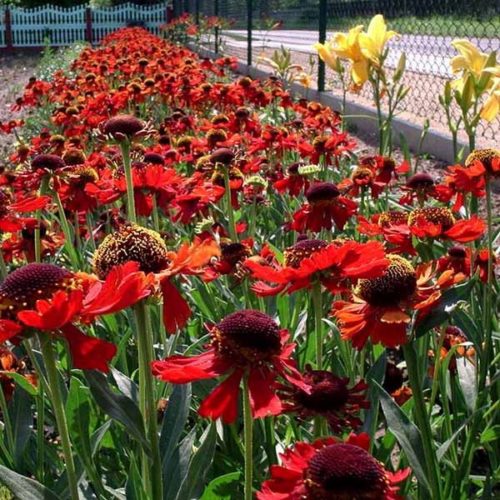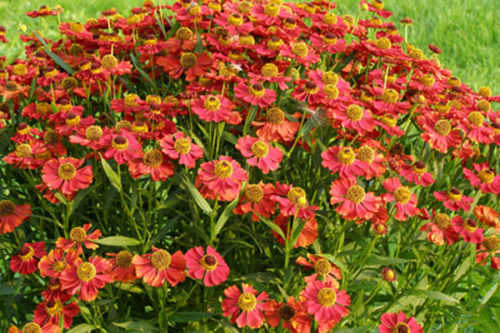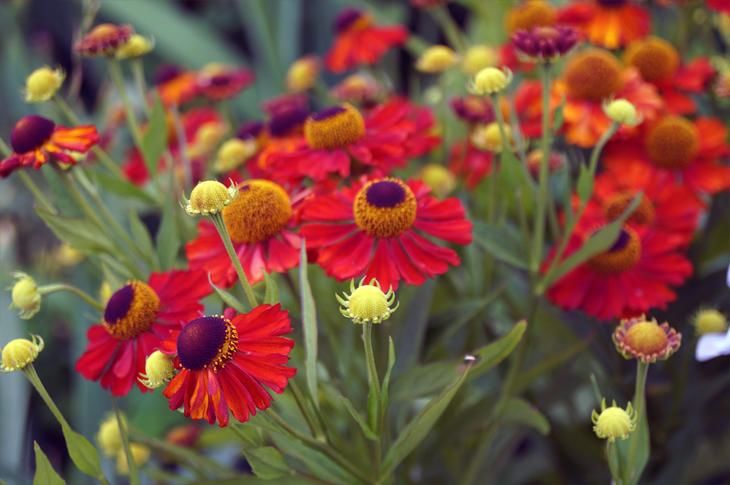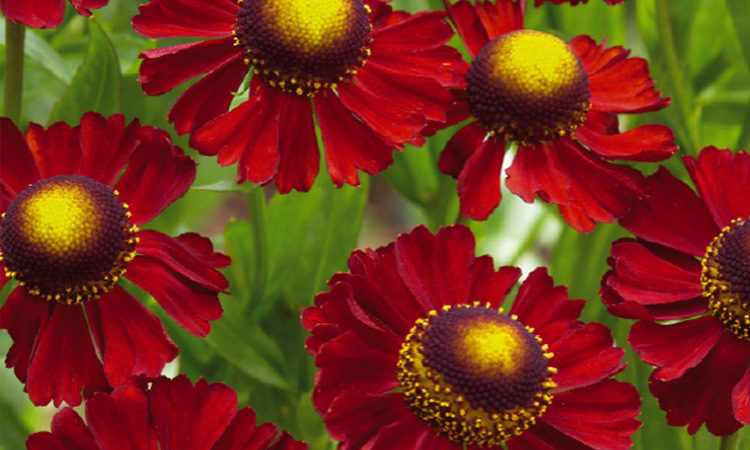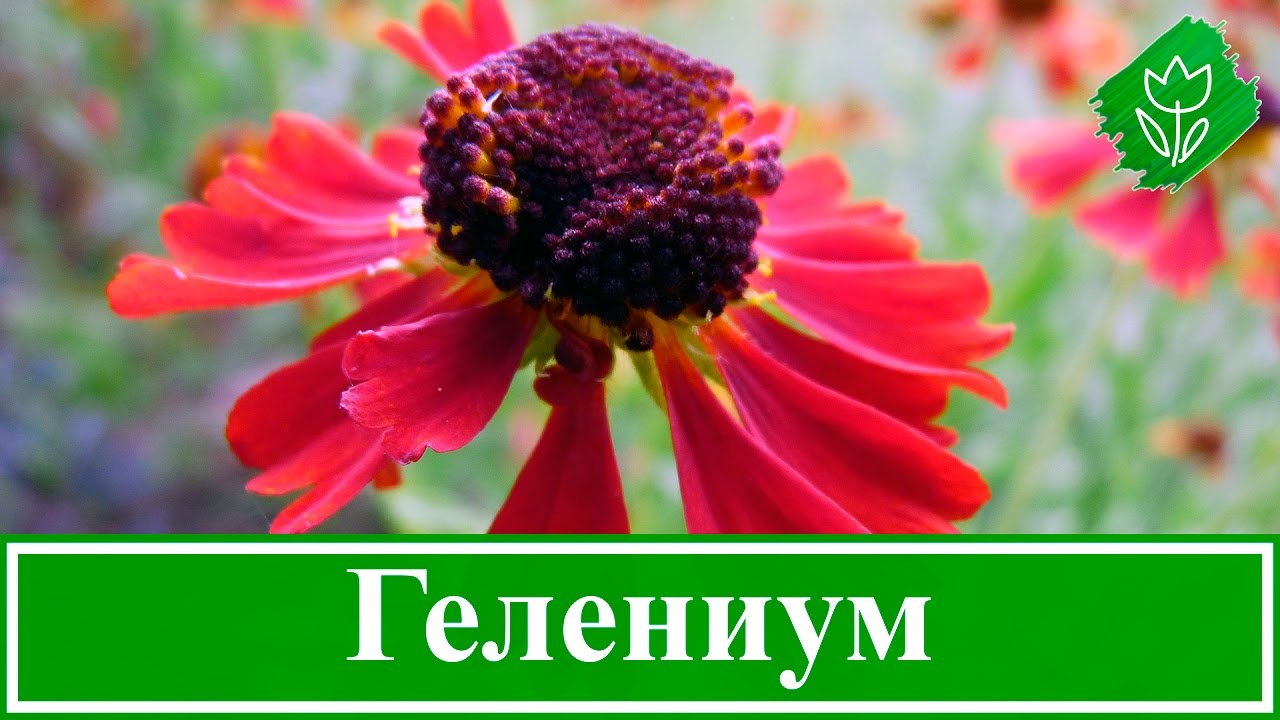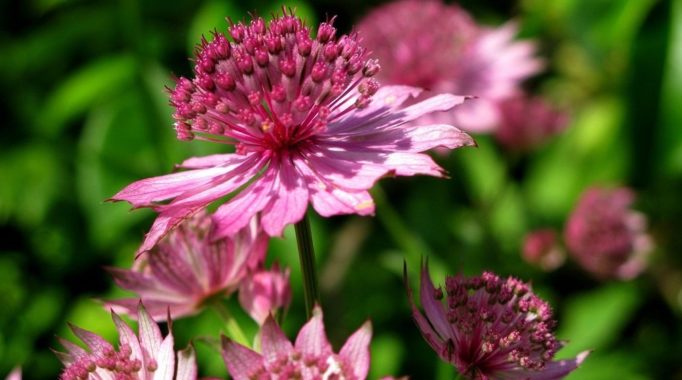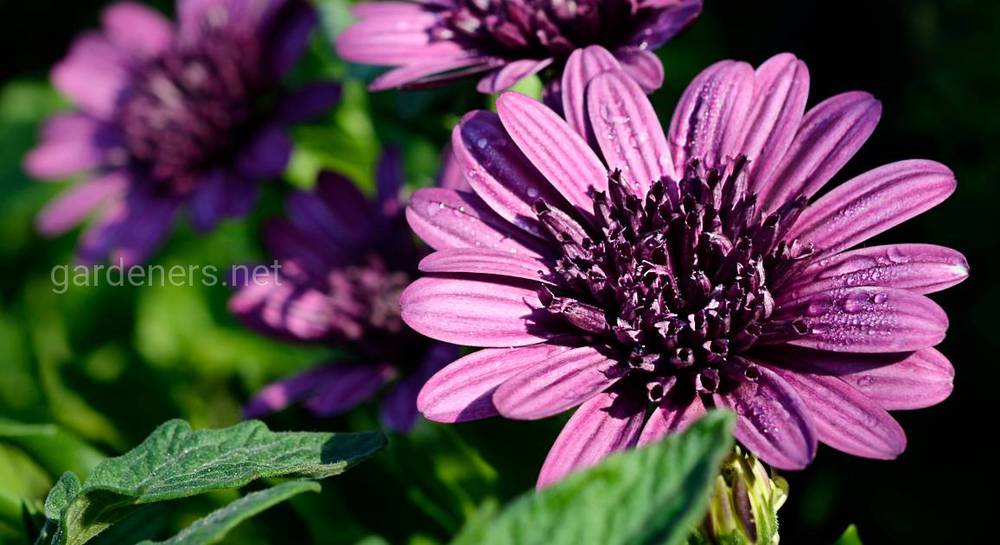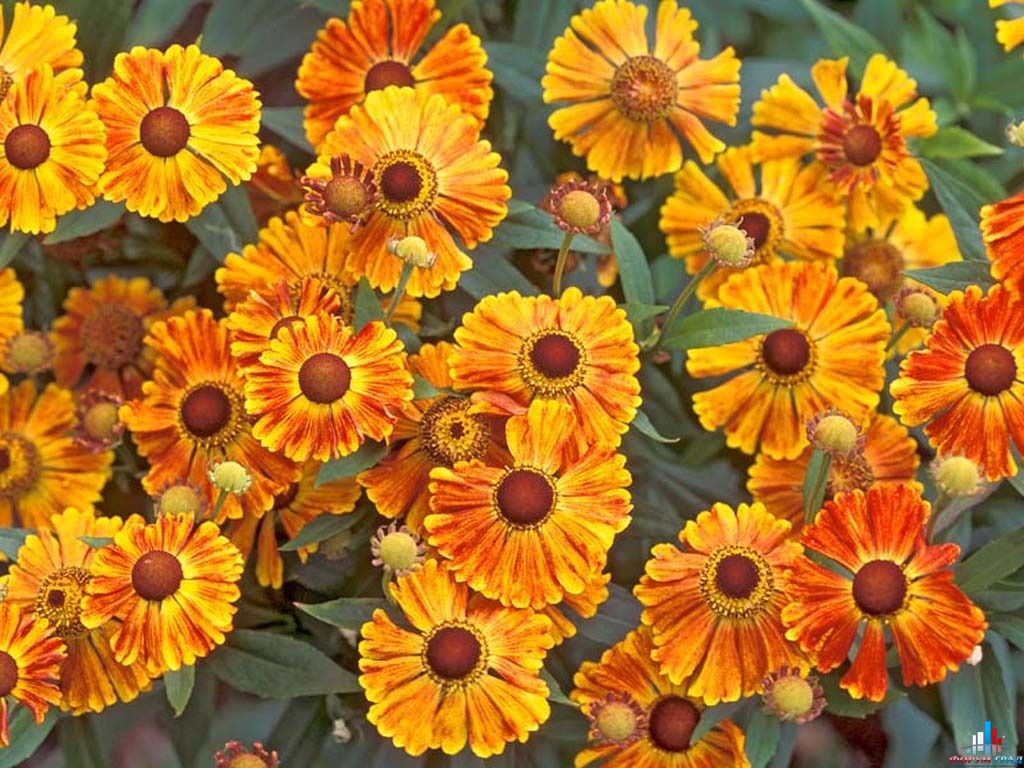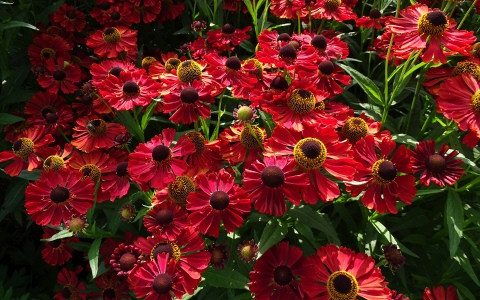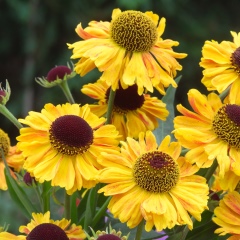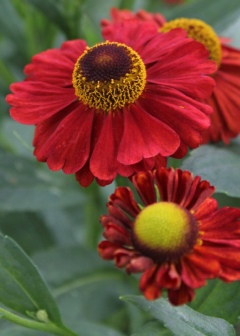Types and varieties of perennial helenium
In nature, there is a huge variety of this perennial plant, it can have different sizes and shades, differ in the flowering period. The most common are red, yellow and bicolor. The most famous varieties of helenium presented below with photos and names.
Bigelow
Variety "Bigelovii" in Western North America can grow up to 80 cm. It has large flowers (6 cm in diameter), painted in brown and yellow. The flowering period is from June to July.
 "Bigelow" is less common than other varieties of gelenium
"Bigelow" is less common than other varieties of gelenium
Spring
Variety "Spring" (Vernalis) - a perennial plant up to 100 cm high. Flowers are large, painted in bright orange color. The buds appear in mid-May and wither towards the end of June.
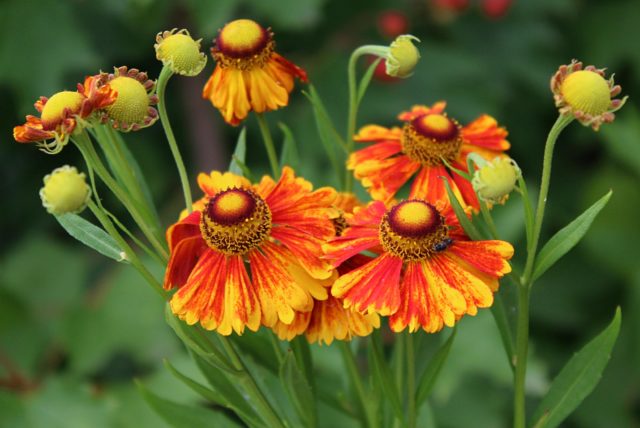 Gelenium "Spring" is frost-resistant, suitable for growing in Siberia
Gelenium "Spring" is frost-resistant, suitable for growing in Siberia
Gupesa
Gelenium "Gupesa" (Hoopesii) is a tall variety (up to 100 cm) with gray-green lanceolate leaves. Inflorescences are bright yellow, solitary, located on long peduncles, in diameter they can reach 9 cm.
 Blooming "Gupes" is observed from June to July
Blooming "Gupes" is observed from June to July
Cockade
"Kokard" (Kokarde) - a variety that grows over a meter in height. It has flowers of an unusual color with red petals, they are brown at the edges and yellow-brown in the center.
 Blossoming "Cockade" begins in August and lasts a month and a half
Blossoming "Cockade" begins in August and lasts a month and a half
Moerheim Beauty
The notable variety "Moerheim Beauty" has reddish-brown flowers, which in buds have shades of yellow, gold and copper. Flowering occurs in July.
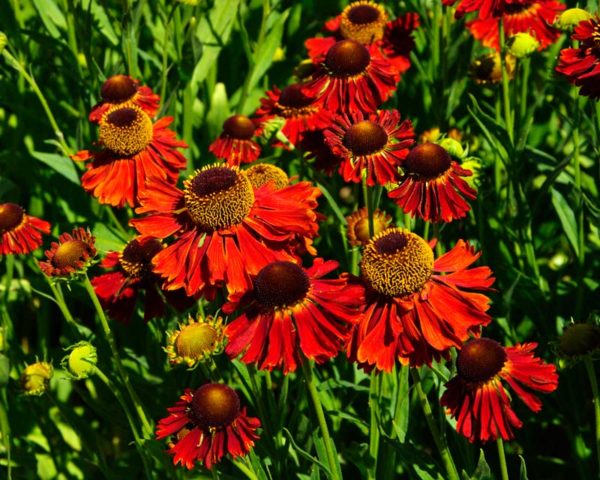 Perennial helenium "Moerheim Beauty" decorates the flower bed with flowers until frost
Perennial helenium "Moerheim Beauty" decorates the flower bed with flowers until frost
Ruby gnome
"Ruby gnome" (Rubinzwerg) has dense bushes with bright ruby-colored inflorescences. The height of the flowers is average, about 60 cm.
 "Ruby Gnome" blooms in the middle of summer
"Ruby Gnome" blooms in the middle of summer
Gelenium varieties
The most common varieties of helenium include hybrid and simple species, which are obtained by breeders as a result of selecting the most beautifully flowering plant specimens. Hybrid varieties of gelenium differ not only in larger buds, but also in the length of their flowering period. As a rule, it exceeds the flowering period of simple flower forms by 1 - 2 months. Next, you can look at the photo of the Gelenium variety and read their brief descriptions in order to choose the type suitable for your garden.
Autumn helenium flowers
Autumn Gelenium is native to North America, including throughout the contiguous United States and most of Canada. It is also popularly referred to as a "sneezing plant".
The flower can grow up to one meter in height. At the end of summer and autumn, flower heads appear with serrated, curved beams of flowers. Caring for autumn helenium is not much different from the agricultural technology of the entire species of these flowering plants. Regular feeding with mineral complexes with a predominance of potassium and phosphorus is required. These trace elements provide long-lasting vigorous flowering.
The species is cultivated as a perennial garden flower. Autumn helenium varieties can vary in color and height. For example:
- Pumilum Magnificum: yellow variety about 60 centimeters long;
- Bruno: red-brown variety;
- Kupfersprudel: yellow or orange;
- Butterpat: golden. All three of the latter varieties have a length of 90 to 110 centimeters.
Flowering time from August to October. Autumn Gelenium prefers full sun and moderate humidity. The flower is very attractive to various types of butterflies.
You should not give the plant an excessive amount of fertilizers during helium care, some varieties do not need them at all. Failure to comply with this rule can lead to abundant flowering and an increase in growth two to three times.
Helenium hybrid
Helenium hybrid includes a huge array of garden hybrids, the origin of which is unclear. Many botanists distinguish autumn helenium as the main variety. They have different characteristics in terms of color, size, leaves, etc.
The most popular varieties are Gartcnsonnе, Gartcnsonnе and Rothaut. They are all taller than one meter with inflorescences from 3.5 to 5.5 centimeters in diameter. Color - yellow-brown.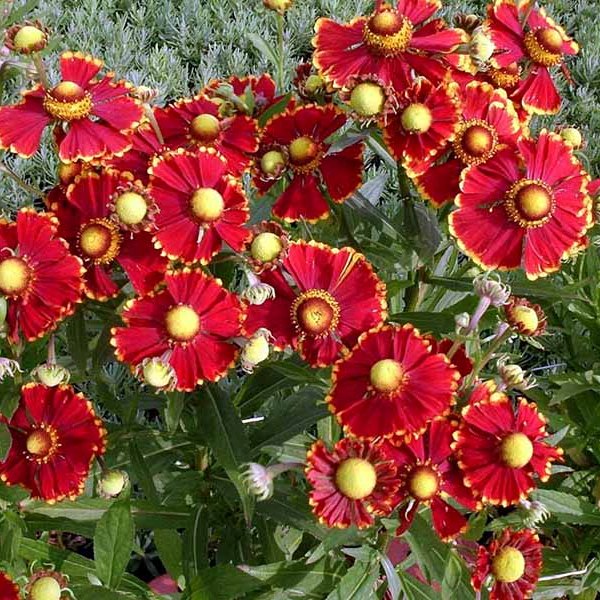
Gelenium Rubinzwerg
Gelenium Rubinzwerg is a very popular shrub variety. It has petals of red, almost ruby color (which is quite consistent with the name of the flower). There is some yellowness at the end of the flower cones. The plant blooms from early July to late September and grows up to 60 centimeters and above.
Gelenium perennial
Gelenium is perennial as the name implies - just that perennial variety, moreover, having a growth of about 89 centimeters. Wet soil with good drainage in a sunny location is preferred. If the soil is heavy, the processes will be very thin. It is necessary to regularly moisten the soil and the flower itself, as well as cut off the overgrown shoots.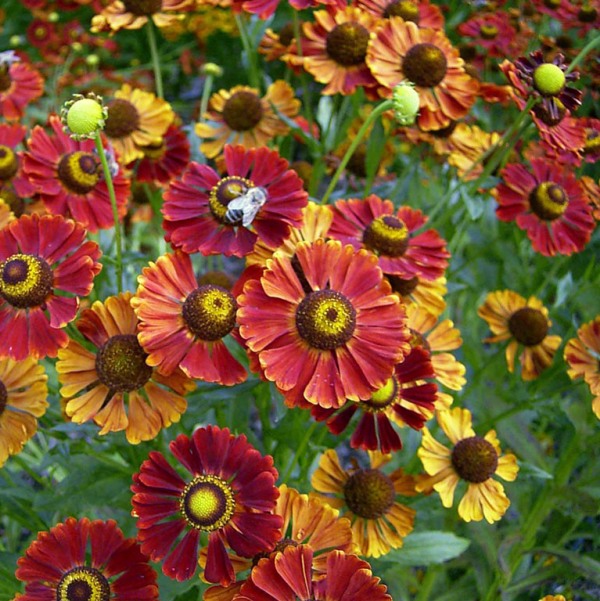
7 Use in landscape design
In the design of the site, helenium is used for the background. Its lush bushes are planted along fences or along the walls of the house. It creates a wonderful backdrop for other plants.
You can only make a flower bed from autumn flowers. Plant asters, chrysanthemums, gerberas and heleniums. The main thing is to correctly combine them in color. The result is a lush flowerbed: green in summer and bright in autumn.
Another way to combine helenium with other flowers is to plant plants that bloom one after another. For example, tulips or daffodils can occupy the foreground of such a flower bed, followed by peonies and carnations. In the middle of summer, dahlias, asters bloom, and behind them geleniums. Such a flower bed will delight with flowers from mid-spring to mid-autumn.

Gelenium flowers go well with marigolds. They are similar in color and splendor of the bushes. In the foreground, the flower beds can be planted with different types of marigolds, and in the back - different varieties of heleniums. It will turn out to be an interesting and bright flower bed.
Many gardeners value and respect helenium, because planting and caring for him do not cause much trouble, but this perennial plant pleases with bright colors all summer and autumn.
Diseases and pests
Gelenium is characterized by increased resistance to diseases, as well as attacks of garden pests. Their only problem is viral diseases that deform flowers and leaves, hinder full growth.
The main danger to gelenium is from snails - they feed on juicy shoots, leaves and flower buds. Lizards, birds, as well as ground beetles, hedgehogs, frogs and shrews are considered their natural enemies.
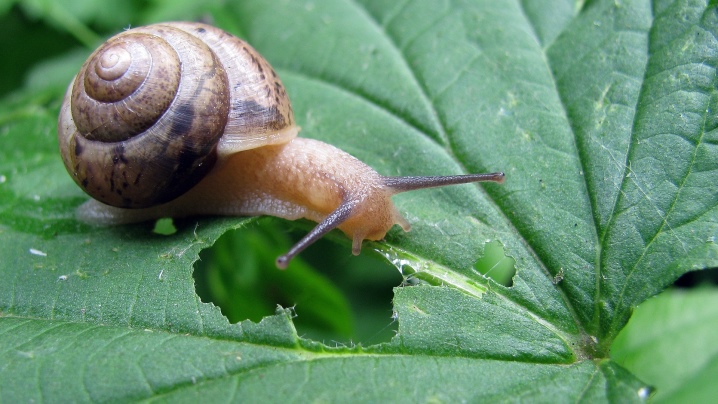
If possible, try to increase their presence in your area. For example, to lure frogs, you can make an artificial reservoir, and for hedgehogs, build a shelter from branches. It is advisable not to use poisonous insecticides in the garden, since they send not only pests, but also useful representatives of the fauna. Also, slugs and snails do not like neighbors such as chamomile, sage and wormwood - if you plant these plants near the beds, you can reliably protect your flowers.
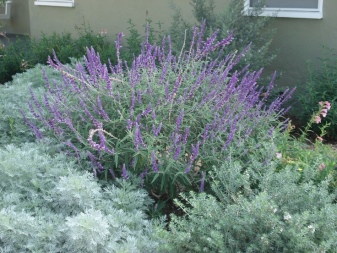
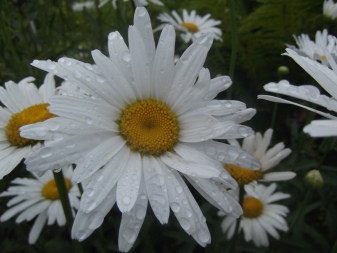
See below for the correct fit of the helenium.
Types and varieties
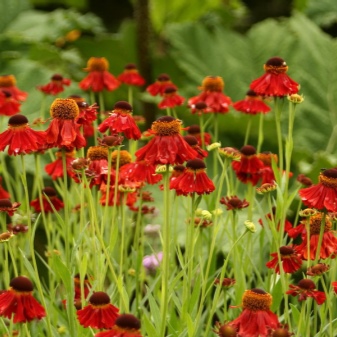
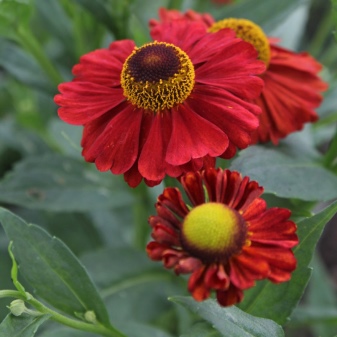



Special attention should be paid to such varieties as Ruby Tuesday (red helenium), Ruby charm, Ruby Tuesday, Rubinzwerg, Hot lava and Sombrero. They are red.
Yellow color is typical for the following varieties.
Moerheim Beauty. This is a low-growing garden helenium, growing up to 80 cm in height. Its flowers are in the form of baskets, the diameter of which is 6 cm. The flowering period of the plant is short, starting in July and ending in August.
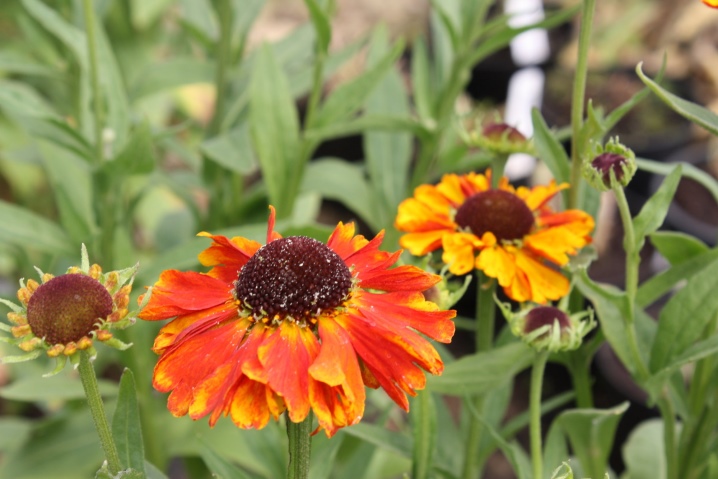


Helena Gold. These are tall plants that can reach a height of 180 cm. The flowering time for helenium begins in mid-August and lasts until the first frost.
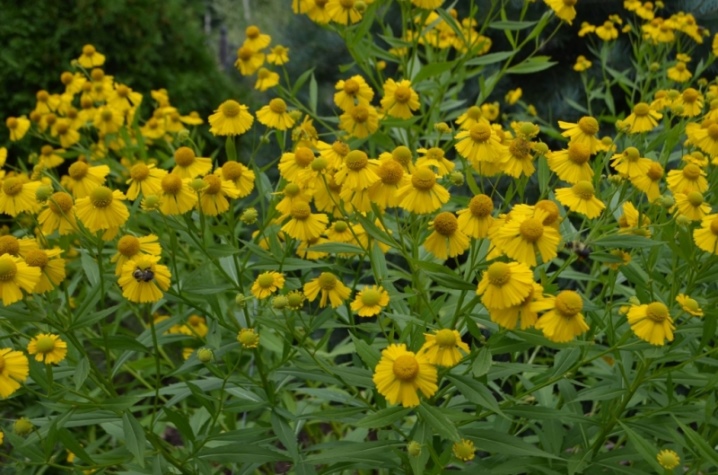
There are also such names of varieties as Betty ("Betty"), "Chelsea", "Voltraut", "Moorheim Beauty" and "Bandera". They are dark brown in color, with red streaks along the edges of the flowers.


All of the above varieties are special in their own way, so each of them can become a real decoration for both large and small garden plots.
Gelenium: photo of flowers and description
The main feature of helenium is that it is not one bush, but many independent plants growing tightly to each other. The height of flowering stems fluctuates from 60 to 180 cm depending on the variety. The size of the "chamomile" is from 3 to 6 cm, the flowers are collected in thyroid-shaped inflorescences and each stem bears up to hundreds of small "suns". The color of the marginal ligulate flowers varies from light yellow to dark red, and can be two-colored. The flowering time depends on the variety, but the plants, if desired, can be selected so that they are decorative from mid-July to early September.
Modern varieties of helenium can be conditionally divided into 3 groups: undersized (from 50 to 90 cm), medium-sized (from 90 to 120 cm) and tall (from 120 cm and above). Among the names, German names often come across and this is not surprising, because helenium is considered the national flower of Germany.

Gelenium perennial ‘Ruby Tuesday’, height (H) 50-60 cm, blooms from July.
Low-growing varieties of helenium
Gelenium hybrid 'Butterpad'
Gelenium ‘Rubinzwerg’
Gelenium 'Wyndley'
Gelenium ‘Crimson Beauty’
Gelenium ‘Sombrero’ (sort group ‘Mariachi’)
Gelenium ‘Bandera’ (cultivar ‘Mariachi’)
Gelenium hybrid 'Siesta' (Mariachi cultivar group)
Gelenium hybrid 'Kupfersprudel'
Gelenium 'Biedermeier'
Medium-sized varieties of helenium
Gelenium ‘Moerheim Beauty’
Gelenium ‘Sahin’s Early Flowerer’
Gelenium ‘Chelsey’
Gelenium ‘The Bishop’
Gelenium perennial 'Bressingham Gold'
Gelenium 'Kanaria'
Gelenium hybrid 'Kupfersprudel'
Gelenium 'Rubinkuppel'
Gelenium ‘Wonadonga’
Tall varieties of gelenium
Gelenium 'Hot Lava'
Gelenium hybrid 'Rauchtopas'
Gelenium perennial 'Vichy'
Gelenium ‘Riverton Gem’
Gelenium ‘Feuersiegel’
Gelenium ‘Chipperfield Orange’
Growing a plant
So, you have chosen a certain type of helenium for your garden. Growing this plant does not require much effort from the grower.
First you need to know what distance should be between the seedlings. 35-45 centimeters will be the most convenient distance. After all, the foliage on the stems is frequent and voluminous. As a result, your flower bed will have about three plants per square meter of area.
If seeds were used for planting, then after sowing they need to be covered with foil or transparent plastic. As soon as you find the first shoots, the protective film must be removed.

In order to sow seeds, you can first get seedlings, and only then plant them in a permanent place. To do this, the seeds must be collected and at the very end of autumn, start sowing.
It is important that the weather is cold, temporary warming can destroy the plant. In the spring, you can plant the plant in open ground
The main condition is the complete melting of snow and the absence of sub-zero air temperatures, even at night. Sudden frosts can kill seeds.
The most important thing about watering is a regular approach. It is best to loosen the soil after moistening it. This will help make the watering process more efficient by increasing air flow to the root of the plant.
During active growth, experts advise applying fertilizers to the soil. Complex formulations are suitable, as well as those that are rich in minerals.
Breeding methods
Most often, new specimens are obtained using seeds, cuttings and rosettes. Seeds can be sown directly into open ground or first get seedlings from them. However, this breeding method is considered the longest.
Experts call the fastest propagation method using cuttings. To do this, you need to cut off the stalk from the shoot, place it for a certain time in a special solution for faster rooting. And then immediately plant it in the ground.
If you use the rosette breeding method, then it is better to do this in the spring. In autumn, there is a danger that young leaves may appear.And with the onset of winter, they will certainly die. Using this method, you need to cut an adult plant with a knife, separate part of the stems, and also cut the root system.

Common diseases and harmful insects
If the foliage and buds began to acquire a darker color, as well as dry out and fall off very quickly, then these damage appeared due to chrysanthemum nematodes. In order to get rid of the pest, you need to process the soil with slaked lime.
If this method does not help, then you will have to cut off the damaged shoots. But in general, helenium is rarely exposed to diseases and damage from harmful insects. With regular watering and top dressing of the soil, this can be completely avoided.
Pruning
The plant needs regular pruning. Closer to winter, its stems will dry out. After they are completely dry, they need to be trimmed. In this case, you should leave about 15 centimeters. Then the remaining shoots need to be covered for the winter. You can use special materials for this, which are sold in stores, or you can simply wrap it with foil.
Use of gelenium for decorative purposes
Gelenium is popular with designers. In landscape design, it is used very often. After all, this plant is distinguished by its unpretentiousness in care, and its appearance is very effective.
Most often, no flower bed can do without gelenium. Tall varieties can be seen in the center of a flower lawn, while low ones are planted at the edges. These flowers are often planted along the paths. Because of their lush foliage, they be hedges.
Gelenium is also actively used in floristry. They are usually complemented by bouquets. Moreover, they need to be used already completely open. If you put them in water, the buds will not open.
6 Diseases and pests
Gelenium is resistant to diseases and pests, but sometimes it gets sick. The most common pest is the nematode, which attacks the stems and buds of the plant. To get rid of it, it is necessary to treat the area with special solutions, and remove and burn diseased bushes.

Common garden pests - aphids and spider mites - can also infect helenium. Usually this is indicated by black dots or a thin white cobweb on the leaves. You can get rid of them with the help of soapy water or chemicals that are sold in garden stores.
Among the diseases, gray rot can be distinguished, which occurs due to excessive watering. Sick plants cannot be saved, they must be removed from the flower bed and watering reduced.
Another common disease is rust. Brown spots on the leaves indicate it. She is treated with special drugs that can be found in flower shops.
Reproduction methods
Gelenium is a bush that looks like a bunch of individual mini-plants. He, like all perennials, has stems that live only one season, the only thing is that in the fall the root collar of this flower also dies off. By this time, the flowers have time to form buds and small rosettes, which successfully continue to grow and develop the next year. Thanks to this feature, helenium propagates well by cuttings. A self-divided bush only needs to be transplanted to a new place, while forced division of the bush should be carried out from time to time, but at least once every three years.
In addition, in the summer, you can propagate the plant with rooted cuttings. Some gardeners successfully propagate helenium using seeds harvested in the fall. This method is considered less effective, since it does not provide good shoots, and the plant may lose its decorative qualities.


Reproduction methods
You can get planting material for perennial helenium in several ways, which are chosen based on the varietal affiliation of the flower and the presence of a mother plant. The most common is the division of the bush, and the less popular is the method of planting by seeds.
Reproduction by division
The most effective way to propagate a culture is division. Mature shrubs consist of numerous shoots that can be successfully separated without causing damage. With this method, they are dug out of the ground entirely, the root system is cleaned, divided into sockets and seated.
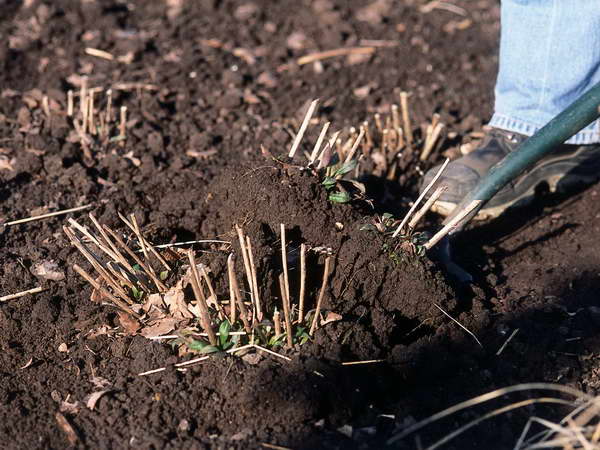 The division of the bushes is carried out in summer or late spring.
The division of the bushes is carried out in summer or late spring.
The division of the bushes is carried out in the summer or late spring.
Propagation by cuttings
The method is not very effective, but if it is performed correctly, the result can be achieved very quickly. Perennial cuttings should be removed from the stems at the time of active vegetation (spring) and soaked in water for a couple of weeks. After sprouting of the roots, the sprouts should be placed in a nutrient substrate and covered with a film. After a few weeks, plant the seedlings in a permanent place.
Seeds
Helenium is obtained from seeds at home or in the open field. This method is usually used in the absence of a mother plant, as well as when growing new varieties.
The method is very laborious, in which it should be borne in mind that not all varieties can grow from seeds
In addition, it is important to use only fresh planting material, since it has poor germination.


